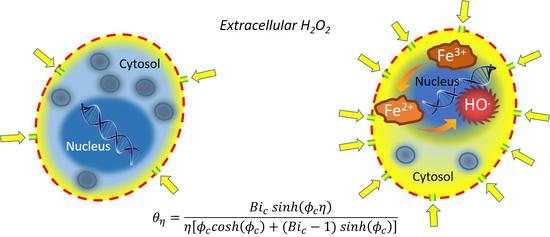Systems Biology Analysis of H2O2 in Cells
Overview
We continue to work with Professor Garry Buettner, Department of Radiology in the College of Medicine at The University of Iowa on several problems relating to kinetic modeling of reactive oxygen species, especially H2O2, in the cell and organelles. In the past, we investigated the role of manganese superoxide dismutase (MnSOD) in the rate of formation of hydrogen peroxide in mitochondria. Hydrogen peroxide concentrations are important since it can at as a signaling molecule at low concentrations but acts as a toxin when the concentrations are high.
We are now addressing the issue as to why some cancer cells are responsive to ascorbate therapy and why others are not. Ascorbate therapy generates high concentrations of hydrogen peroxide that permeates cell walls. Left unchecked, the hydrogen peroxide can react with labile metals to generate hydroxyl radicals. These resulting hydroxyl radicals can damage the cell DNA. Normal cells are believed to have high catalase concentrations that breakdown hydrogen peroxide as well as low reactive metal ions. However, many cancer cells are susceptible, making ascorbate therapy an appropriate adjuvant for cancer treatment. The variability in the plasma membrane permeability to hydrogen peroxide as well as the differences in catalase concentrations in the cell are being investigated as the reasons for differences in cancer cell susceptibility across cell lines.
Related Publications
Erudaitius DT, Buettner GR, Rodgers VGJ (2020) The latency of peroxisomal catalase in terms of effectiveness factor for pancreatic and glioblastoma cancer cell lines in the presence of high concentrations of H2O2: Implications for the use of pharmacological ascorbate in cancer therapy, Free Radical Biology and Medicine, Volume 156,Pages 20-25, ISSN 0891-5849.
Erudaitius D, Mantooth J, Huang A, Soliman J, Doskey C, Buettner GR, Rodgers VGJ (2018) Calculated Cell-Specific Intracellular Hydrogen Peroxide Concentration: Relevance in Cancer Cell Susceptibility during Ascorbate Therapy. Free Rad. Biol. Med. Vol. 20, pp. 356-367.
Erudaitius D, Huang A, Kazmi S, Buettner GR, Rodgers VGJ (2017) Peroxiporin Expression Is an Important Factor for Cancer Cell Susceptibility to Therapeutic H2O2: Implications for Pharmacological Ascorbate Therapy. PLoS ONE 12(1): e0170442. doi:10.1371/journal.pone.0170442.
Buettner GR,Wagner BA, Rodgers VGJ (2011) Quantitative Redox Biology: An approach to understanding the role of reactive species in defining the cellular redox environment, Cell Biochemistry and Biophysics, Online, DOI: 10.1007/s12013-011-9320-3.
Ng CF, Schafer FQ, Buettner GR, Rodgers VGJ (2007) The rate of cellular hydrogen peroxide removal shows dependency on GSH: mathematical insight into in vivo H2O2 and GPx concentrations, Free Radical Research, 41(11) 1201–1211.
Buettner GR, Ng CF, Rodgers VGJ, Schafer FQ, (2006) A New Paradigm: Manganese Superoxide Dismutase Influences the Production of H2O2 in Cells and Thereby their Biological State, Free Radical Biology and Medicine, 41(8) 1338-1350.
